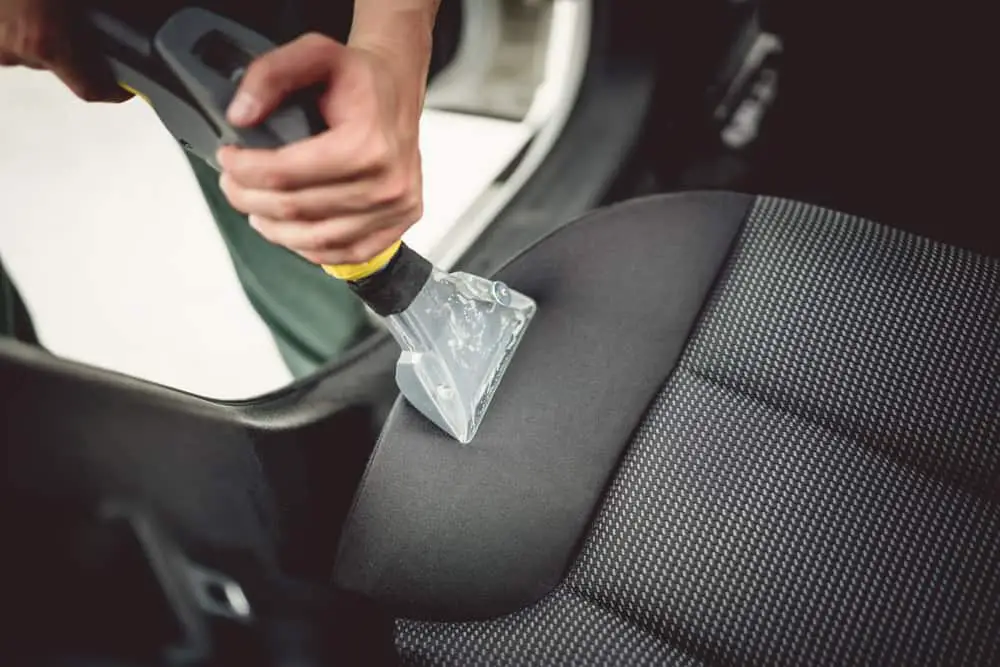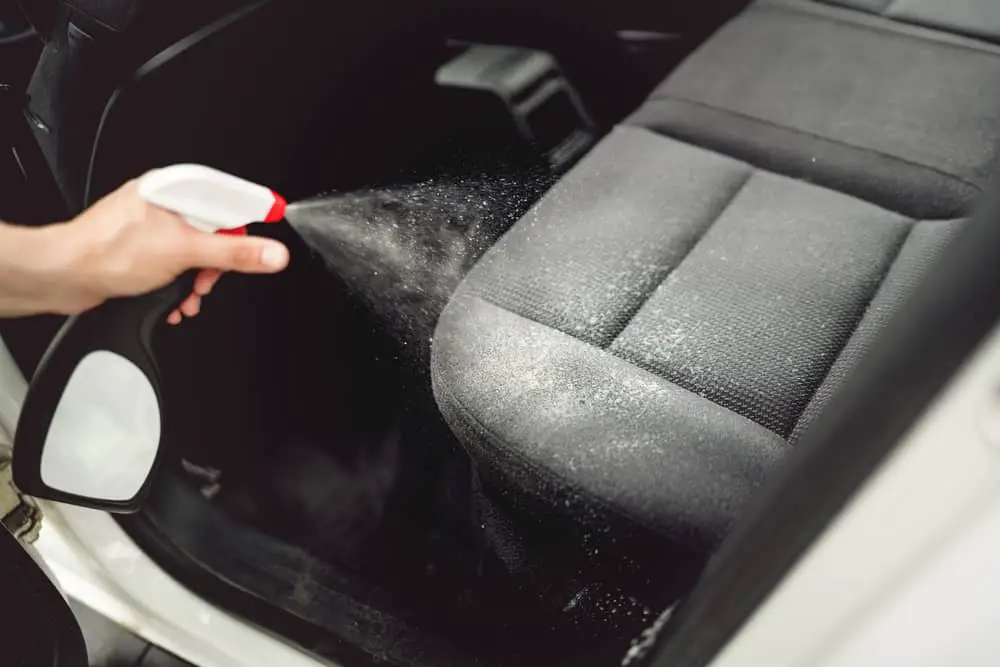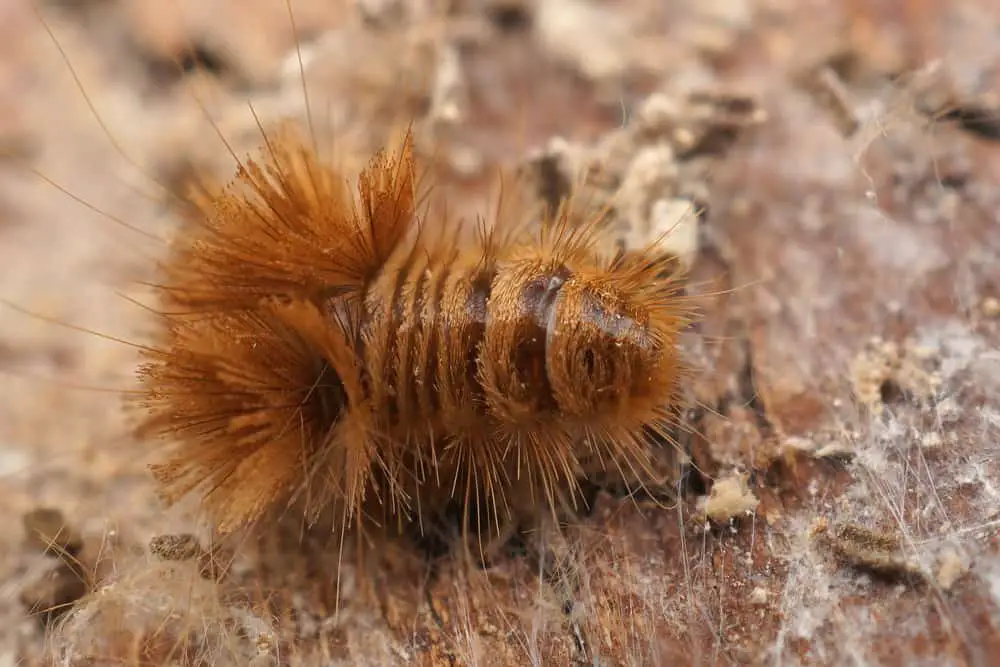Carpet beetle larvae can be a pesky problem for any car owner, as they thrive in the warm, dark environment provided by your vehicle’s floor mats and upholstery.
These tiny insect larvae may be small, but they can cause significant damage to your car’s interior by feeding on the fibers in the carpet.
To tackle this issue, you need to understand the nature of carpet beetle larvae and their breeding habits. These little creatures are attracted to textiles, natural fibers, and other organic materials, making your car’s interior the perfect home for them. Once inside, they can rapidly multiply, causing severe damage and an unpleasant environment for you and your passengers.
Effective methods for getting rid of carpet beetle larvae in your car involve regular cleaning, using natural and chemical treatments, as well as taking preventive measures.
Identifying Carpet Beetle Larvae in Cars
Carpet beetles are common pests that can infest various spaces, including vehicles. Identifying carpet beetle larvae in your car is essential to effectively get rid of them and protect your vehicle’s interior. This section will help you distinguish between adult beetles and their larvae.
Adult Beetles vs Larvae
Adult beetles are small, oval insects, typically measuring 2-5 mm in length. They have a somewhat rounded shape, and their bodies are covered in tiny, overlapping scales, giving them a textured appearance. Adult carpet beetles are usually brownish-black or mottled with yellow, white, or orange spots.
On the other hand, carpet beetle larvae are:
- 1/8 to 1/4 inch long
- Elongated and somewhat cigar-shaped
- Brown or black, often with light-colored bands
- Hairy or bristled
- Responsible for the damage to carpets, upholstery, and other materials in the car
Carpet beetle larvae feed on a wide variety of materials, including natural fibers like wool, cotton, silk, leather, and fur – all of which can be found in car interiors. When searching for carpet beetle larvae in your car, pay attention to:
- Carpeting
- Seat upholstery
- Floor mats
- Storage compartments
Signs of carpet beetle larvae in your car:
- Chewed or worn fabric
- Damaged leather or upholstery
- Shed skins from the larvae as they grow
- Fecal pellets
In some cases, you might also find eggs laid by adult carpet beetles in your car. These pale yellow or white eggs are tiny, oval-shaped, and commonly found hidden in fabrics or other areas where the larvae will have immediate access to a food source.
Cleaning and Vacuuming the Car

Vacuuming Regularly
One of the most effective ways to get rid of carpet beetle larvae in your car is to vacuum regularly. At least once a week, thoroughly vacuum all carpets, upholstery, and fabric items in the car, including seat covers and floor mats. Use a high-quality vacuum cleaner with a HEPA filter to ensure that all larvae and their eggs are sucked up and removed.
When vacuuming, make sure to cover all corners and hard-to-reach areas. It’s also a good idea to use attachments like crevice tools and upholstery brushes to ensure thorough cleaning. Focus on areas that are more prone to harbor larvae, such as car seat seams and floorboard corners.
Steam Cleaning the Car
In addition to vacuuming, steam cleaning your car’s interior can help eliminate carpet beetle larvae. Using a steam cleaner with a high temperature setting can effectively clean and sanitize your car’s carpets and upholstery. This method not only removes larvae but also kills eggs, preventing future infestations.
Before steam cleaning, remove all loose items like floor mats and seat covers. Then, fill the steam cleaner with water and add a few drops of essential oil beetle spray for added effectiveness. Carefully steam clean all fabric surfaces, ensuring that high-traffic areas receive extra attention.
For leather surfaces, use a leather-specific steam cleaner attachment or a gentle, soap-based cleaner and a soft-bristle brush to clean and sanitize the material. Be mindful of the temperature and steam exposure time on leather surfaces, as too much heat or moisture can damage the material.
Removing Eggs and Larvae
Inspecting the Car
To effectively get rid of carpet beetle larvae in your car, begin by thoroughly inspecting the interior. Look for signs of infestation, such as small holes in upholstery and fabric or shed skin from the larvae.
Pay close attention to nooks and crannies, under seats, and in corners where they might be hiding. Remove any wool, burlap, cloth, and cotton items, as these can serve as food sources for the larvae.
Natural Repellents and DIY Techniques
There are a few natural repellents and DIY techniques that can help eliminate carpet beetle larvae. Some of these include:
- Boric acid: Sprinkle boric acid powder in areas where you have noticed the larvae. It acts as a natural insecticide, killing the pests without causing harm to humans or pets.
- Diatomaceous earth: Apply food-grade diatomaceous earth in the same areas, as it is a natural insecticide that works by dehydrating the insects.
- Vinegar: Mix equal parts of white vinegar and water, and spray it on the infested areas. Vinegar helps in killing the larvae and also disinfects the surfaces.
- Cedar oil: Spray cedar oil on infested areas, as its scent acts as a natural repellent to carpet beetles. It will help in killing both the larvae and eggs.
Make sure to remove trash and vacuum your car thoroughly to eliminate any remaining larvae, eggs, and possible food sources.
Insecticides and Chemical Treatments

If natural methods are not sufficient, you may need to resort to insecticides and chemical treatments. Consult with a professional pest control company to determine the best course of action. They will likely recommend appropriate treatments, such as insecticide sprays or fumigation.
Whenever using insecticides and chemical treatments, always read and follow the label instructions carefully. This ensures the safe and effective use of the products and minimizes any health risks to you, your family, and your pets.
By following these steps, you can effectively eliminate carpet beetle larvae in your car, keeping your vehicle clean and free from these nuisance pests.
Preventing Future Infestations
Seal Crevices and Cracks
To prevent carpet beetle larvae infestations in your car, start by sealing all crevices and cracks. Inspect areas such as under the seats, in the trunk, and around the doors. Use a sealant to fill these gaps. This will keep insects from entering your vehicle and laying eggs on organic materials like fur, leather, and feathers.
Regular Car Maintenance
Performing regular maintenance on your car can help in preventing future infestations. Clean your car thoroughly, paying attention to seat covers, mats, and blankets. Vacuum your car’s interior, and remove trash, lint, and other debris regularly. Keep your parking spot clean and avoid parking near damp areas or piles of trash, as these locations can attract insects.
Pest Control Methods
Using natural pest control methods can be effective in keeping carpet beetle larvae at bay. A good option is peppermint, known to repel insects. Place a few drops of peppermint oil on cotton balls and leave them in your car, replacing them as needed. You can also use insecticides specifically designed for carpet beetles but always follow the label directions.
Using Synthetic Fabrics and Materials
Since carpet beetle larvae feed on organic materials, opting for synthetic fabrics and fibers in your car will deter them. When choosing seat covers, mats, and other accessories, consider materials that are not made from natural fibers. By doing so, you’ll deny the larvae of carpet beetles their main food source, thereby reducing the risk of infestations.
When to Seek Professional Help
Assessing the Severity of Infestation
It’s essential to determine the extent of the carpet beetle infestation in your car before deciding to seek professional help. Look for signs such as:
- A large number of adult beetles flying around or crawling on your car seats.
- Damage to your car’s upholstery, carpet, and fabric due to larvae feeding.
- The presence of shed skins and fecal pellets indicates active larvae.
If you notice these signs and the infestation seems too extensive for you to handle, it might be time to call a professional pest control service.
Choosing the Right Pest Control Service
When looking for a pest control service to eliminate carpet beetle larvae in your car, consider the following:
- Reputation and experience: Look for a company with a proven track record of successfully dealing with carpet beetle infestations. Check reviews and ratings to get an idea of their service quality.
- Chemicals and insecticides: Ensure the company uses appropriate chemicals and insecticides suitable for treating carpet beetles and is safe for your car’s interior.
- Prevention measures: A good pest control service will not only eliminate the current infestation but also provide guidance on prevention measures to avoid future infestations.
- Cost and narrow sidelines: Compare price quotes from multiple companies. However, don’t choose a company solely based on cost – quality of service is crucial too. Narrow your selection down to the best fit for your needs.
Remember, if the infestation is minor, you might be able to handle it yourself using natural methods like clove oil. But if you’re overwhelmed, or the infestation seems to be beyond your control, seeking professional help is a wise decision.
Conclusion
In summary, carpet beetle larvae can be a nuisance in your car, but there are effective ways to eliminate them. Start by cleaning and vacuuming your car thoroughly, ensuring you reach all nooks and crannies.
Next, consider using a combination of chemical and non-chemical treatments such as insecticides, diatomaceous earth, and natural repellents like lavender oil. Remember to always follow the manufacturer’s instructions for safety.
By staying vigilant and regularly inspecting your car for signs of infestation, you can help prevent these pests from taking over your vehicle. Keep in mind that prevention is always better than cure, so maintaining a clean car environment is essential. Happy driving!


